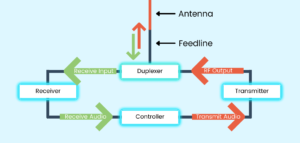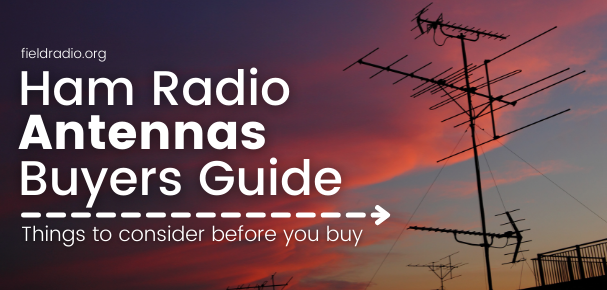You have bought a nifty little Ham radio. You also have your FCC Ham radio license and your own call sign and are ready to communicate without relying on conventional communication channels.
But will your little ham radio be able to transmit to a station on the other side of the city? Not likely.
Does that mean you can never reach out to the Ham radio enthusiasts outside your vicinity?
Fortunately, you can.
There are pre-installed, ready-to-use devices that can help you communicate well beyond your locality, even when using a low-powered radio.
And the best part? You only have to learn how to use them. Someone else has already done the hard part of buying and setting them up!
These devices are called Ham radio repeaters. And in this article, I will share all you need to know about them.
What Are Ham Radio Repeaters?
Ham radio repeaters are two-way radiocommunication devices. They have a transmitter and receiver working simultaneously to receive weaker signals, strengthen them, and transmit them over a wider area, ensuring that the signals get better coverage without degradation.
These efficient devices have different receiving and transmitting frequencies and greatly supplement ham radio communications. Without them, you may not be able to communicate to and from far-off areas on your regular VHF/UHF frequencies.
If you have a technician class license, you can put up your own ham radio repeater, expand your radio reach and help other Hams in your community connect with a wider audience.
How Far Can Ham Radio Repeaters Reach?
The reach of a ham radio repeater depends on several technical and non-technical factors.
The technical factors include the device’s power and the height and quality of the antenna being used.
Ham radio repeaters can operate on 50 watts, 100 watts, and even 500 watts.
But regardless of how high the power is, if the antenna isn’t high enough, the repeater may not be able to broadcast over an appreciably broad range. Therefore, the antenna should rise above all obstructions to receive and transmit signals effectively.
Apart from these technical aspects, there are certain geographic and topographic elements as well that can influence the range of the repeater.
If the repeater is located on an elevated building and you live in a relatively flat geographic region, you can expect your repeater to pick up signals from 15-30 miles away and transmit them over 50-100 miles.
Of course, these ranges are just approximations based on several factors. Having said that, they may vary from repeater to repeater.
Where Are Ham Radio Repeaters Located?
Ideally, Ham radio repeaters should be placed where they could communicate directly with other stations. This is important because these systems work on radio waves, which in turn depend on line-of-sight propagation, and any obstruction in their path may lead to the destruction of the wave and severed communication.
This is why Ham radio repeaters are mostly installed on high elevations. Common places where you may find these repeaters include mountain tops, communication towers, and atop high-rise buildings.
In essence, the higher the elevation of the repeater antenna, the better the footprint or coverage of the repeater.

How Do Ham Radio Repeaters Work?
You know what Ham radio repeaters do. And knowing that, you might be wondering how they do what they do.
So, in this section, I’ll explain the complex working of Ham radio repeaters in simple terms.
A Ham radio repeater typically comprises an antenna that transmits and receives signals, a transmitter and a receiver, a duplexer, a feedline, and a controller.
The antenna transfers the signals it receives to the receiver, turning it into an audio signal.
The audio signal goes to the transmitter, where an exciter modulates it to the transmit frequency. A power amplifier boosts this frequency to a higher level so the signal can travel farther without degradation.
Now, to ensure that the transmitter and receiver don’t interfere with each other’s signals, Ham radio repeaters use a duplexer. The duplexer isolates the signals, so the transmitter and receiver signals don’t intermix.
From the duplexer, the signal then travels through the feedline back to the antenna and is broadcasted in all directions.
This entire process is monitored and controlled by the controller, which serves as the “brain” of the repeater.

Ham Radio Repeater Frequencies and Offset
We know by now the Ham radio repeaters work on two different frequencies. They receive signals at one frequency, called the input frequency, and transmit at another frequency, which we call the output frequency.
The difference between the input and output frequencies is called the offset and is a critical element when communicating via Ham radio repeaters.
The offset can be either positive or negative. For the most commonly used 2m band, the offset is +/- 600 kHz. or +/- 0.6 MHz, while for the 70 cm band, the offset is +/- 5 MHz.
Confusing? I know. Let me explain with an example.
Suppose the transmit or output frequency of the repeater you are trying to access is 145.110 MHz, and it has a negative offset of 0.6 MHz. In this case, its receiving frequency will be 145.110 – 0.6 = 144.510 MHz.
That means, when you want to monitor this repeater, you will tune into 145.110 MHz. and when you want to transmit through it, you will tune in to 144.510 MHz.
Most modern Ham radios are programmed to automatically adjust the transmitting and receiving frequencies based on the offset.
This means that if you are tuned into receiving the signals from the repeater at 145.110, and you want to transmit through this repeater, your radio may automatically tune you into the repeater receiving frequency (144.510) as soon as you press the mic button.
How Can I Access A Ham Radio Repeater?
Accessing a ham radio repeater is more than just keying in the right frequency, pressing the mic button, and broadcasting.
You need to know some critical information and program your radio accordingly to be able to use the repeater.
The first thing you must know is the repeater’s input frequency. Since all directories list repeaters’ output or transmit frequencies, you must know its offset to find the repeater’s receiving frequency.
That makes offset the second thing you must know before accessing the repeater.
Finally, most repeaters these days are closed. So, you must “unlock” them first to access them and broadcast over a wider range.
Your transmitting signal should carry a low-level frequency, or a sub-audible tone called a CTCSS tone to access the repeater. The repeater receiver is programmed to listen to this tone and pick up only those signals that carry this tone.
So, you must program the repeater’s transmit frequency along with the offset in your radio and then feed in the tone value to access the repeater.
Where Can I Find Local Ham Radio Repeaters?
Finding local ham radio repeaters is super easy. Numerous online directories, like www.repeaterbook.com, have a comprehensive list of repeater frequencies. These directories also include each repeater offset and sub-audible tone in the list.
So, you can log on to any one of these directories and get all the values you need to program your Ham radio for any repeater you like accurately.
How to Use a Ham Radio Repeater?
You already know how to access a Ham radio repeater from the section above. But knowing the technical details and values is not enough for you to start using a radio repeater.
There are certain etiquettes of using a Ham radio repeater that you must know and follow unless you want to come off as an uncouth Ham.
These etiquettes, call them rules if you want, include:
- First, listen to ensure that no one else is speaking and then transmit.
- Never transmit without a license unless it is a life-or-death emergency and there are no other means of communication available.
- Announce the station’s call sign you are trying to reach, followed by your own call sign. Then wait for the station to respond.
- If you are using the repeater for the first time, announce your call sign along with the repeater you are using.
- Use plain language when using ham radio repeater for emergency communication.
- Be as concise as you can while using the repeater to make sure the repeater remains free for other people who may be in distress.
- When using a repeater, always leave a few seconds gap between each subsequent transmission so anyone with an emergency can key in.
Final Word
Ham radio repeaters expand the coverage of smaller, weaker ham radios and greatly supplement Ham radio communications.
You can find your local Ham radio repeaters through online directories. But before you can start using any repeater, you have to program the frequency, offset, and tone of each repeater you wish to use in your radio.
Additionally, there are certain etiquettes of using a repeater. Make sure to abide by them so you can become a respected member of the Hams’ community.
Finally, you must know that these repeaters are powered by electricity. And if your local repeaters source electricity from the grid, they may go out of power when there is an electric breakdown.
Some repeaters are also powered by solar panels and generators. But those can fail too.
So, prioritize connecting with your local Hams to whom you can reach out to without repeaters.

I have been passionate about the world of communications in its various forms for most of my life. Ever since I first found an old ham radio stashed away in my uncle’s attic, I have had a fascination with this classic technology.
Having the ability to communicate with people without the need to rely on telephone lines or networks is an empowering feeling which I believe everyone should have at least a basic knowledge of. Becuase who knows when you might need it?
I setup fieldradio.org with this passion in mind, to help inform people about the amazing possibilities of amateur radio and I’m on a quest to help educate as many budding operators as possible.
I hope you enjoy our content. Come and say hi, via our contact form


